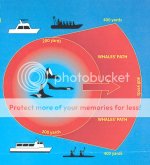thataway":2j2zx0h8 said:
Phil,
Those are magnificent photos and video! Very impressive.
I have learned a lot more about Orcas from this thread. I never saw any in S. Calif. despite having boated there over 50 years. They have also been spotted up in the Gulf of Mexico. (Rarely).
One question which I didn't ask, but perhaps Jim or Phil could answer is what legally should you do when you accidentally come within the legal distance of a whale, Orca or dolphin. (around here we see dolphin every day, and our experience world wide is that they will play around the bow and wake.) I have seen the "watching boats" feed dolphin, which is illegal, but no one enforces the law.
Our tactic is to shut down the engine and drift until the sea creature goes on about their business of obtaining food, unless we are on passage, and then we just continue on course at hull speed or less.
Federal law regarding Orcas is 200 yards laterally, 400 yards if you are in front of them, and "not in their path." You are not to be "in their path,' nor impede their progress. Washington state laws are similar. For other protected marine mammals, it is 100 yards.
And the rub: the Killer Whales have apparently not received this information. They do NOT travel in a straight line - they follow their food. Sometimes they mill around in one area, other times they are making 7 knots or more. You can be 220 yards away one moment, and then have one come up much closer than that. That would be a violation, and you will be cited if it is seen OR reported (and there are a lot of people out there who
want to report you). The fines can be as much as $50,000 (civil action).
So, what to do when a whale surfaces closer than 200 yards? The Pacific Whale Watch Association has set guidelines (those same guidelines were used to write the current law): no props turning if closer than 200 yards; engine off if you happen to be within 100 yards ("and take your lumps" - that was a quote). Work away from them perpendicular to their path when you can. No faster than 7 knots within 1/2 mile of the whales. Don't run anywhere in front of their suspected path (drop off, move out, and go behind).
In this area, NOAA and WDFW are the enforcement, and if seen or reported in violation, you will be cited. Your "intent" will not be considered in writing the ticket, but you can try to use that in court. No gray area - if you are too close, you are in violation.
We carry a rangefinder at the helm. You can also use radar to determine range. I see violations every time I'm out there, but not intentionally by the commercial operators. Private boaters run right up on the whales, cut directly in front of them, and follow too closely. SoundWatch and StraightWatch are out there almost everyday, and they take down the numbers if they can get them. Same with the various research boats (a few have special permits that allow them to be closer for the research they do).
This is the only part of the job that I don't enjoy - you can be doing everything right, and still wind up in violation. We are required to write any "close encounters" in our log, and steps taken to move away. We log locations, specific pods and individuals, along with the usual log notations (weather, sea state, etc).
The laws in Canada are what the US laws used to be: 100 yards. Some of the Canadian operators seem to be under the mistaken impression that they can use that distance in US waters. Some of those fast big ribs do blast in and out much faster than 7 knots.
"Continuing on course" if it takes you in the path of, or too close to, the whales would also put you in violation. Yes, even if you didn't know they were there.
My suggestion for private boaters would be to stay even with or outside the commercial boats. The word I got was 94% of the violations reported were recreational boats. Records are kept and "any pattern of violation" will be considered when being cited.
Here is an illustration regarding the laws...

We have come across the whales in our own boat, when no other vessels are around. We enjoy watching, but still keep our distance. Some boaters think the laws only apply to commercial operators - VERY wrong. Even kayakers have to abide by the same laws. These animals are amazing to watch - it never gets old. The behavior and the pods are different every time. The first time you see "Granny" ( a female estimated to be around 100 years old), or "Mike" (a male with a very large dorsal fin), and see their family behavior and the way they work together... well, it is impressive.
When we are home in Texas, the dolphins are a delight because they seem to
want to be with the boats. They will swim up to the boat to the point where you are looking eye to eye with them. They are playful and curious. I don't see that same degree of curiosity with the Killer Whales, but they are fascinating to watch.
I did make a report last week to SoundWatch of an open bow runabout, with a kid on the bow with legs draped over, running right up on the whales. When there are other boats on the scene who are obviously keeping a proper distance, I can't imagine the people on that boat didn't think, "Hey, maybe we shouldn't be this close?" Of course, these are probably the same people who think it's OK to put their kid on the back of a bison at Yellowstone National Park! :disgust
Hope that wasn't too wordy.
Best wishes,
Jim


